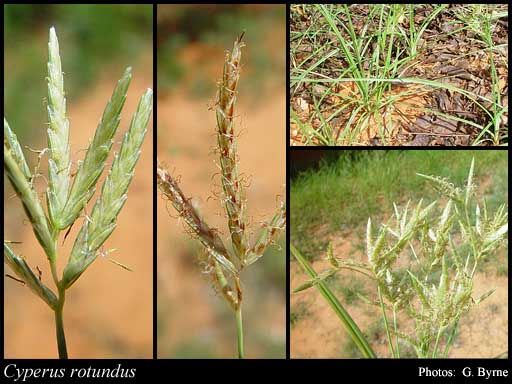- Reference
- Sp.Pl. [Linnaeus] 1:45 (1753)
- Conservation Code
- Not threatened
- Naturalised Status
- Alien to Western Australia
- Name Status
- Current
Rhizomatous and tuberous, perennial, grass-like or herb (sedge), 0.15-0.6 m high. Fl. green-brown, Apr to Jul. Wet sand. Disturbed sites.







Distribution
- IBRA Regions
- Carnarvon, Dampierland, Geraldton Sandplains, Indian Tropical Islands, Jarrah Forest, Murchison, Pilbara, Swan Coastal Plain, Victoria Bonaparte.
- IBRA Subregions
- Chichester, Dandaragan Plateau, Eastern Murchison, Fitzroy Trough, Geraldton Hills, Hamersley, Keep, Northern Jarrah Forest, Perth, Pindanland, Roebourne, Wooramel.
- Local Government Areas (LGAs)
- Ashburton, Broome, Carnarvon, Chittering, Christmas Island, Derby-West Kimberley, East Pilbara, Gingin, Greater Geraldton, Karratha, Stirling, Wanneroo, Wiluna, Wyndham-East Kimberley.
Management Notes (for the Swan NRM Region)
Alternative Names. Coco-grass, Purple Nut Sedge.
General Biology. Growth form. Sedge. Life form. Perennial. Reproduction. Primarily tubers and rhizome, occasionally seed. Dispersal. Soil, water (flooding), wind, nursery stock. Seedbank persistence. Seed viability low, dormant tubers can remain viable for up to 10 years.
Notes. Can displace native plants and change the availability of food or shelter for native animals. Although relatively small in size it is highly competitive for resources. Has rapid growth, is able to produce an extensive system of rhizomes and tubers and can quickly form dense colonies. Most seed produced is not viable. Hundreds of tubers can be produced in one season at the tips of the rhizome. Tubers require a chilling period to break dormancy and produce a primary small basal bulb beneath the soil surface. Cultivation stimulates growth. Tubers are vulnerable to drying and die at low moisture content levels. Plants are susceptible to shading, which reduces vegetative growth and tuber production. Grows well across a range of soil types, soil moisture, pH and elevations, and grows best in moist fertile soils. Tubers can lie dormant in the soil for up to 10 years until stimulated to sprout. Predicted to increase in abundance with elevated CO2 levels. Has allelopathic properties. Intolerant of dense shade.
Additional information. Origin. Pilbara and Kimberley Regions of Western Australia. History of use/introduction. Nursery stock, ship ballasts, contaminated seed/crops.
Suggested method of management and control. Difficult to control once established. Hand remove small/isolated plants ensuring all tubers and rhizomes are removed. Responds differently to glyphosate depending on growth stage. Apply glyphosate at label rate before the fifth leaf stage - after this time herbicide is not translocated to tubers. Repeated applications are usually required for effectiveness. Read the manufacturers' labels and material safety data sheets before using herbicides. For further information consult the Australian Pesticides and Veterinary Medicines Authority to determine the status of permits for your situation or state.
Management Calendar
| Calendar Type | Jan | Feb | Mar | Apr | May | Jun | Jul | Aug | Sep | Oct | Nov | Dec | Comments |
|---|---|---|---|---|---|---|---|---|---|---|---|---|---|
| Germination | Y | Y | Y | Y | Y | ||||||||
| Active Growth | Y | Y | Y | Y | Y | Y | Y | Y | Y | ||||
| Flowering | Y | Y | Y | Y | |||||||||
| Fruiting | Y | Y | Y | ||||||||||
| Manual Removal | O | O | O | O | O | O | O | O | O | O | O | O | |
| Herbicide Treatment | Y | Y | Y | Y | Y | Y |
Legend: Y = Yes, regularly, O = Occasionally, U = Uncertain, referred by others but not confirmed.
References
- Ameena, M. & George, S. (2004) Control of purple nutsedge (Cyperus rotundus L.) using glyphosate and 2,4-D sodium salt. Journal of Tropical Agriculture, 42 (1-2): 49-51.
- Bariuan, J.V., Reddy, K.N. & Wills, G.D. (1999) Glyphosate injury, rainfastness, absorption, and translocation in purple nutsedge (Cyperus rotundus). Weed Technology, 13 (1): 112-119.
- Brown, K. & Brooks, K. (2002) Bushland Weeds: A Practical Guide to their Management. Environmental Weeds Action Network, Greenwood.
- Crop Compendium (Undated) Cyperus rotundus L. bayer Crop Science URL: http://compendium.bayercropscience.com/BAYER/CropScience/CropCompendium/BCSCropComp.nsf/id/EN_Cyperus_rotundus?open&ccm=200030 - Accessed August 2010.
- Fuentes, R.G., Baltazar, A.M., Merca, F.E., Ismali, A.M. & Johnson, D.E. (2010) Morphological and physiological responses of lowland purple nutsedge (Cyperus rotundus L.) to flooding. AoB Plants, June 29.
- Hussey, B.M.J., Keighery, G.J., Dodd, J., Lloyd, S.G. & Cousens, R.D. (2007) Western Weeds. A guide to the weeds of Western Australia. 2nd Edition. The Plant Protection Society of Western Australia, Victoria Park.
- IUCN SSC Invasive Species Specialist Group (ISSG) (2009) Global Invasive Species Database: Cyperus rotundus (sedge). URL: http://www.issg.org/database/species/ecology.asp?si=1448&fr=1&sts=&lang=EN - Accessed August 2010.
- Pacific Island Ecosystems at Risk (2008) Plant threats to Pacific ecosystems. URL: http://www.hear.org/pier/scinames.htm - Accessed January 2010.
- Parsons, W.T. & Cuthbertson, E.G. (2001) Noxious weeds of Australia. 2nd Edition. CSIRO Publishing, Collingwood.
- Rogers, H.H., Runion, G.B., Prior, S.A., Price, A. J., Torbert, H.A. & Gjerstad, D.H. (2008) Effects of elevated atmospheric CO2 on invasive plants: comparison of purple and yellow nutsedge (Cyperus rotundus L. and C. esculentus L.). Journal of Environmental Quality, 37 (2): 395-400.
- Sharma, R. & Gupta, R. (2007) Cyperus rotundus extract inhibits acetylcholinesterase activity from animal and plants as well as inhibits germination and seedling growth in wheat and tomato. Life Sciences, 80: 24-25.
- Urbatsch, L. (2000) Plant guide: Exotic weed species, Purple Nutsedge (Cyperus rotundus). URL: http://www.hear.org/pier/pdf/nrcs_plant_guide__cyperus_rotundus.pdf - Accessed December 2007.
- USDA, ARS, National Genetic Resources Program (2009) Germplasm Resources Information Network - (GRIN). National Germplasm Resources Laboratory, Beltsville, Maryland. URL: https://npgsweb.ars-grin.gov/gringlobal/taxon/taxonomysimple.aspx - Accessed October 2009.
- Wilen, C.A., McGiffen, M.E. & Elmore, C.L. (1999) UC pest management guidelines, Nutsedge. URL: http://www.ipm.ucdavis.edu/PMG/PESTNOTES/pn7432.html - Accessed December 2007. University of California Statewide Integrated Pest Management Program.